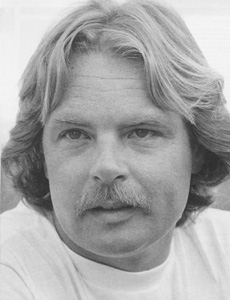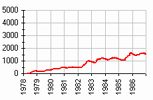Гонщики, R | |
Rosberg, Keke Курсивом отмечены гонщики, |
| Кеке РосбергRosberg, KekeRosberg, Keijo |
 (c) 'Who is Who' by Steve Small, 2000 Родился: 06.12.1948 Стокгольм, Швеция Сезонов в Ф1: Лет в Ф1: 9 Гран При: Старты: 114* *не стартовал: 19 Победы: - подряд: Подиумы: - подряд: 3 Поул-позиции: - подряд: 2 Первый ряд: - подряд: 2 Быстрые круги: - подряд: 2 Лучший финиш: Лучший старт: 1 Дубли: Хет-трики: Лидирование старт/финиш: Большие шлемы: Круги: - лидирования: 512 Километры: - лидирования: |
Год | Команда | Шасси |
The buccaneering Finn became a firm favourite in the mid-eighties after he had taken a surprise World Championship win in a season clouded by tragedy. His subsequent exuberant performances, stabbing the turbo-powered Williams around the world's circuits with frightening commitment, did much to supply the entertainment factor which was often missing from the sport.
Born in Sweden of Finnish parentage, Keijo Rosberg was three times his country's karting champion before moving with equal success into the rough-and-tumble world of Formula Vee and Super Vee, taking the Castrol GTX title in the latter category in 1975. He found a seat in the Toj Formula 2 team in 1976, but apart from a fourth place at Rouen this was not a successful alliance. By the end of the year Keke had linked up with Fred Opert, who satisfied the Finn's insatiable appetite for racing in 1977 by running him first in New Zealand, where he took the Stuyvesant title, and then in the European Formula 2 championship and the Labatt's Atlantic series in North America.
There was no let-up the following year when Rosberg undertook a mind-numbing schedule which totalled some forty races. In addition to repeating the previous season's marathon stint for Opert, Keke moved into Formula 1 and scored a shock win in a rain-drenched International Trophy race for the new Theodore team. Although this result was something of a fluke, there was no doubting the Finn's stunning car control, and his name was noted down as one to watch by Formula 1 team managers. In World Championship races, of course, it was a different story, as he struggled to make an impression in three different makes of car.
Resigned to a season of Can-Am in 1979, Rosberg was often quicker but, tellingly, also more erratic than champion Jacky Ickx, but a route back into Grand Prix racing was to re-open after James Hunt's sudden retirement. His half-season in a difficult car failed to provide any satisfactory results, but he was back in the frame to stay. When Wolf amalgamated with Fittipaldi for 1980 Keke was part of the package, and on his maiden outing at Buenos Aires he scored his first championship points. However, the team lacked the technical and financial resources to make a real impact and Rosberg was forced to make up the numbers until the end of 1981 when it closed its doors.
The cards suddenly began to fall for the Finn when he took over the Williams seat vacated by Alan Jones at the start of 1982. Within two races the team's other star driver, Carlos Reutemann, had also walked away from Grand Prix racing and suddenly Keke was leading the team. Showing incredible maturity for one not familiar with racing at the sharp end of the grid, Rosberg made the odd mistake but maximised every potential points-scoring opportunity and took a splendidly thought-out win in the Swiss GP at Dijon. By the end of the year he had overhauled the unfortunate Didier Pironi's points total and claimed a fairytale World Championship triumph. The following year saw Keke hampered by a lack of turbo power, but this didn't prevent him taking a classic win, driving on slicks throughout, on a damp track at Monaco. He took the Cosworth car into battle with great ferocity elsewhere, never admitting defeat when many others would have been content merely to cruise round. When he finally got a turbo engine himself, Keke was to be frustrated by the poor handling of the Williams chassis, but nevertheless he scored perhaps the best win of his career in searing heat in Dallas in 1984 when most of his rivals failed to avoid a meeting with the concrete walls. Rosberg's relationship with Williams was never completely harmonious and he wanted away at the end of the season but, forced to see out his contract, he got on with the job without further complaint. Initially at least, he was unhappy with the arrival of Nigel Mansell for 1985 but soon established a rapport with his new team-mate. Having agreed a lucrative deal with McLaren, Rosberg signed off from Williams with a sparkling win in Adelaide to start the final short chapter of his Grand Prix career, but the partnership was to be something of disappointment for both sides, with Keke rather taken aback by his inability to come to terms with the talents of Alain Prost.
Rosberg quit without regrets, but stayed closely involved with the sport, making a return to the wheel in the World Sports Car Championship with Peugeot in 1991. With Dalmas, he took wins at both Magny Cours and Mexico, before switching to the German touring car championship the following year to race a Mercedes. Apart from his role in guiding young Finnish talent (the careers of both Mika Häkkinen and JJ Lehto are under his shrewd managership), Keke has formed his own DTM/ITC team, running works-backed Opels and led by the experienced Klaus Ludwig. In 1995 he announced another retirement but it wouldn't be a massive surprise if we saw him behind the wheel again in selected events in the future.
(c) 'Who is Who' by Steve Small, 2000
| © WildSoft, 1995-2020 |


